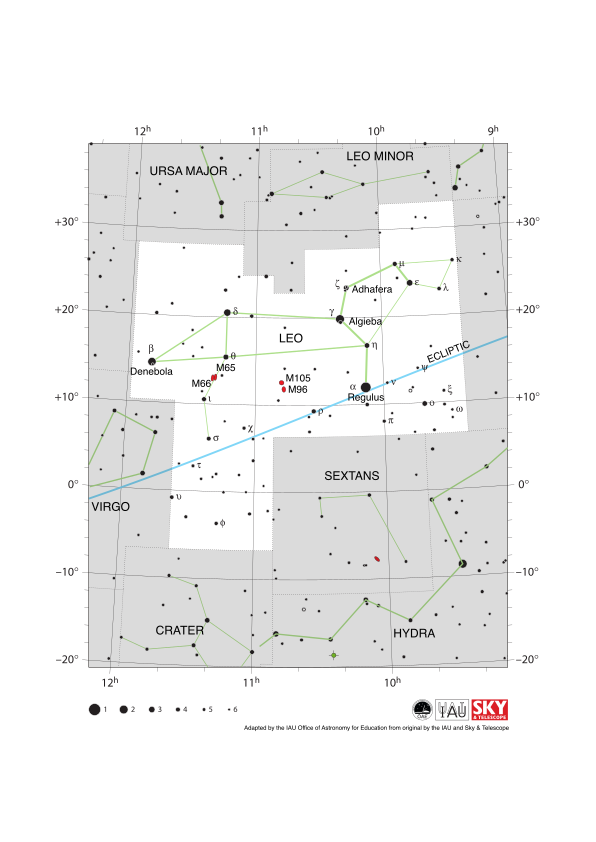Download File (
image 114.25 kB)
Download PDF File (
PDF file 186.50 kB)
Diagram caption:
The zodiac constellation Leo and its surrounding constellations. Starting from the top of the diagram and going clockwise, these are Leo Minor, Cancer, Sextans, Hydra, Crater, Virgo and Ursa Major. The brightest star in Leo, Regulus, lies almost exactly on the ecliptic (shown here as a blue line): the path the Sun appears to take across the sky over the course of a year. The Sun spends the period from mid August to mid September in Leo. The other planets in the Solar System can often be found in Leo.
Leo spans the celestial equator and is thus part of it is visible at some time in the year from all of planet Earth with some of the constellation obscured for the most arctic and antarctic regions of the world. Leo is most visible in the evenings in the northern hemisphere spring and southern hemisphere autumn.
Several objects can be seen in Leo, including M65 and M66 – two galaxies in the Leo Triplet, a trio of galaxies including NGC 3628, not listed here. In addition, M96, a spiral galaxy, can be seen as a fuzzy object using a small telescope, and Messier 105, an elliptical galaxy. Each of these objects are labelled on the map as red ellipses.
The y-axis of this diagram is in degrees of declination with north as up and the x-axis is in hours of right ascension with east to the left. The sizes of the stars marked here relate to the star's apparent magnitude, a measure of its apparent brightness. The larger dots represent brighter stars. The Greek letters mark the brightest stars in the constellation. These are ranked by brightness with the brightest star being labelled alpha, the second brightest beta, etc., although this ordering is not always followed exactly. The dotted boundary lines mark the IAU's boundaries of the constellations and the solid green lines mark one of the common forms used to represent the figures of the constellations. Neither the constellation boundaries nor the lines joining the stars appear on the sky.
Diagram credit: Adapted by the IAU Office of Astronomy for Education from the original by IAU/Sky & Telescope. Credit Link
Diagram translation status: Not yet approved by a reviewer
Related glossary terms:
Apparent Magnitude
, Cancer
, Celestial Coordinates
, Constellation
, Declination
, Elliptical Galaxy
, Galaxy
, Leo
, Right Ascension (RA)
, Spiral Galaxy
, Virgo
, Zodiac
, دایرةالبروج
Categories:
Naked Eye Astronomy
Diagram license: Creative Commons تخصیص 4.0 بینالمللی (CC BY 4.0) Creative Commons تخصیص 4.0 بینالمللی (CC BY 4.0) icons









